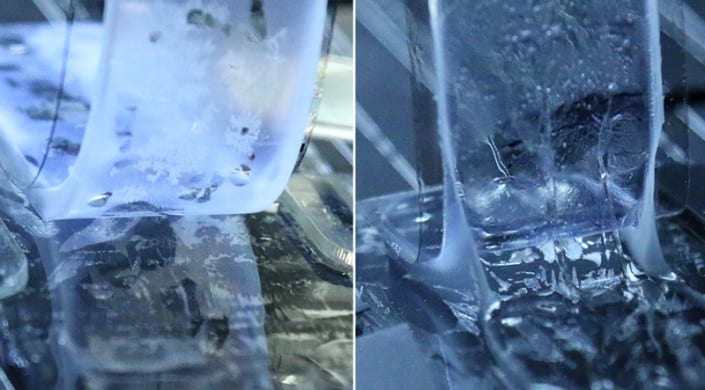The future is soft. As technologies advance in flexible robotics and wearables, industry increasingly needs new methods to fasten different materials together in manufacturing. Researchers from the Harvard John A Poulsen School of Engineering and Applied Sciences (SEAS) have devised a method using chemical additives that do not change the properties of soft materials such as elastomers and hydrogels, but which lock materials to which they have been added together.

An unmodified hydrogel peels away from an elastomer (left). Materials treated with the handshake coupling agents (right) are far harder to peel apart. Image: Suo Lab/Harvard SEAS
Currently, soft materials can only be attached to each other using glues or surface treatments. This, however, can restrict the manufacturing process, adding multiple stages and difficult-to-handle materials. The SEAS method, described in Nature Communications, builds bonding into the materials rather than using a separate agent to bond.
The researchers concentrated on elastomers and hydrogels because these are the most common building blocks for soft devices; hydrogels often being electrically conductive and elastomers being insulators. Both types of materials are built up from chemical precursors, which are liquids that are polymerised to make a soft solid. The researchers mixed chemical coupling agents into the precursors. Resembling molecular hands with small tails, the agents embed themselves into the polymer network, with the tail fixed into the bulk of the polymer and the hand remaining open at the surface. When the hydrogel and elastomer are combined in a manufacturing process, the free hands “reach across” the boundary between the two materials and “shake”, creating chemical bond at the interface.
The coupling materials are silanes; a silicon atom to which have been added four functional groups. Three of these make up the “hand”: these are groups that can undergo hydrolysis. The fourth is an organic chain, which during polymerisation is chemically incorporated into the polymer. The “hands” form strong siloxane bonds.
The researchers show that the method can bond together two pieces of material as though they were glued, but with no need to apply glue to the interface. It also allows coating and printing of different soft materials in different sequences.
“The manufacturing of soft devices involves several ways of integrating hydrogels and elastomers, including direct attachment, casting, coating, and printing,” said Canhui Yang, a postdoctoral fellow at SEAS and co-first author of the paper. “Whereas every current method only enables two or three manufacturing methods, our new technique is versatile and enables all the various ways to integrate materials.”
As a bonus, the technique can also help to make hydrogels, which are mostly composed of water, heat resistant. Using the handshake coupling agents, a coating can be bonded to the material extending its effective temperature range. For example, a hydrogel-based wearable with the coating could be ironed.
“Several recent findings have shown that hydrogels can enable electrical devices well beyond previously imagined,” said Prof Zhigang Suo, senior author of the paper. “These devices mimic the functions of muscle, skin, and axon. Like integrated circuits in microelectronics, these devices function by integrating dissimilar materials.”
A bonding method which does not compromise the physical properties of materials could therefore greatly expand the types of device that could be made, he added.










Taking steps toward reindustrialisation
High value is not the same as high cost/price and does not need excessive automation. Appropriate and innovative manufacturing tools are what led (in...